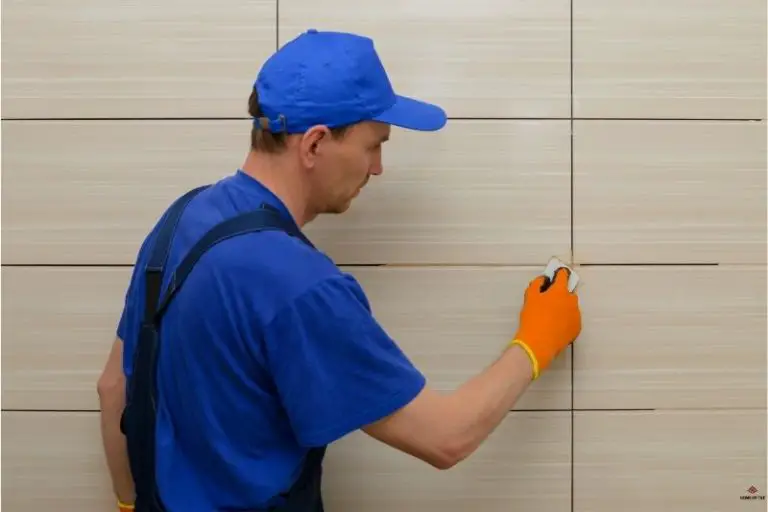How To Install Ceiling Tiles, 8 Things You Should Know
There are various ways to install ceiling tiles, and as long as you follow the correct steps, you can complete the job successfully without a professional’s help.
To install ceiling tiles, you can use the surface mount or direct apply method or the drop-in or suspended method. The method you use will depend on how high your ceiling is. The direct apply method is ideal for low ceilings, while a drop-in installation works well with a high ceiling.

A perfect ceiling tile finish can beautify a room, making it look neat, and this article will discuss everything you need to know. Let’s get started!
Contents
How Do You Install Ceiling Tiles?
You can install ceiling tiles using the drop-in (suspended) ceiling method or the surface mount (direct apply) method. Drop-in installation is ideal for high ceilings, while surface mount installation is suitable for low ceilings.
I’ll discuss these 2 methods in greater detail below:
● Drop-In Installation
It’s best to choose this style if you have high ceilings since it reduces their height and helps reduce heating and cooling costs.
Below are the steps to follow:
- Step 1. Hang the metal grid: If your ceiling doesn’t already have a metal grid to accommodate the ceiling tiles, you can buy and install one. Hang the grid 3 inches (8 cm) below the standard ceiling. Nail the crown molding around the roof before suspending the main beams with the hangar wires. Install the cross tees to create square grids with pop-in rivets.
- Step 2. Measure the grid: Use a ladder and tape measure to measure the grid’s square footage by placing it from the wall to the cross T. Also obtain the dimensions for the roof fixtures, such as the lights, chandeliers, and air vents. Note down your measurements before climbing down.
- Step 3. Cut the ceiling tiles: Transfer the measurements onto the tiles using a pencil and a T-square to draw the cut-off lines. Use a carpet knife to cut along the line and separate the tiles. Cut out the spaces for the fixtures in their correct positions on the tiles.
- Step 4. Create a shadow line on the cut edges: Take the resized tile and place it in the grid. Use a knife or pencil to run a line along the grid’s border to determine where to put the shadow line. Place the tile on a flat surface and use a shadow line cutter to remove the edge. Repeat this process for all the tiles.
- Step 5. Pop the tiles into the grid: Climb the ladder and install the tiles into the grid. They should fit easily without being too snug.
● Surface Mount Installation
This installation style is best if you have low ceilings and don’t want the room to feel cramped.
- Step 1. Measure the room size: Use a measuring tape to determine the length and width of the ceiling, so you can buy the correct number of tiles. Multiply the two figures to get the square footage.
- Step 2. Order the tiles: Start by dividing the room’s square footage by that of the ceiling tile you want to install to determine the accurate number you’ll need. Add 15% to that number to cover any mistakes you make while cutting or installing the tiles.
- Step 3. Remove fixtures from the ceiling: Turn off the circuit breaker before removing the roof attachments to prevent electrical accidents. You need to remove fixtures, such as lights, ceiling fans, and air vent covers, because they can make it difficult to install the tiles. You also risk damaging them during installation.
- Step 4. Clean the ceiling: A dirty roof can prevent the tiles from adhering firmly to the ceiling. Use a broom if the roof isn’t overly dirty, but if it is, use a sponge and an all-purpose cleaner to scrub a small section. Allow the ceiling to dry before continuing.
- Step 5. Locate the center of the room: Measure the ceiling with a tape measure to determine the halfway point from each side of the wall and mark it with a pencil. Stretch a snapping chalk line along the ceiling to connect the two points with a control line. Make a 90-degree turn and create another line to form a cross – this is where you’ll start installing the tiles.
- Step 6. Apply adhesive to the back of the tiles: Use a putty knife or foam brush to place the glue on the four corners of the ceiling tiles and in their center.
- Step 7. Mount the tiles to the ceiling: Apply the tiles starting from the center of the ceiling where the control lines meet until you reach the wall. Use your palms to firmly press the tile to the ceiling before installing the next one.
- Step 8. Cut the tiles for fixtures: Dry fit tiles that require cutouts by applying duct tape to the pieces before fitting them to areas near fixtures. Measure the size of the fixture holes from the edge of the tile to the middle of the opening, and transfer the measurements to the tiles. Use carpet scissors or tin snips to cut.
- Step 9. Cut tiles for the edges: When you’ve installed the full tiles, use a tape measure to determine the dimensions of the remaining space. Using these measurements, cut the tiles to size and apply them to the edges.
- Step 10. Fix the cornice or crown molding: These can help to conceal the tile edges and give your tile ceiling a beautiful, polished look. Add adhesive to cornices and press them firmly to the wall. Once done, clean the tiles with a dry cloth and reinstall all the fixtures.
Ways To Install Drop Ceiling Tiles
You can install a drop ceiling using these steps:
- Step 1. Measure and sketch the roof: Determine your room’s length and width to help draw up the correct grid size on graph paper. This will help you create equal-sized panels and order the accurate number of materials.
- Step 2. Determine where to place the grid: Measure 3-6 inches (8-15 cm) from the top of the ceiling downwards and mark the point. This will enable you to fit fixtures easily and pop the ceiling tiles into the grid. Use a four-foot level or snapping chalk line to draw lines around the room’s perimeter before nailing the molding to the wall.
- Step 3. Find the studs in the wall: Use a stud finder to determine where the studs are. Mark them with a pencil so you can tell where to screw the wall angles.
- Step 4. Hang the wall angles: Trim the angles to fit on the walls using tin snips. Line up the wall angles along the line on the wall and secure them with screws in the areas where the studs are. These wall angles will support the runners or rods and tiles.
- Step 5. Fix hanging screws: Clamp a string from one end of the wall to the other to guide you where to place the eyelet anchors. Fit the screws on the joists about 3 feet (0.9 meters) from each other, and pass a wire through them before bending it at the top with pliers.
- Step 6. Attach the main tees: Place the runners perpendicularly to the joists from one end of the wall to the other and rest them on the wall angles. Pass the hanging end of the wires through the holes on the main tees, and bend them with pliers to keep the rods secure. Ensure the runners are straight while you hang them to avoid a slanting tile ceiling. If not, adjust the wires accordingly.
- Step 7. Install the cross tees: Attach the cross tees to the main tees, as per your measurements. Use a grid punch to create rivet holes in the cross tees before placing pop-in rivets inside to keep the grid square.
How Do You Install Tin Ceiling Tiles?
Tin ceiling tiles are beautiful, and you can install them in two different ways:
● Direct Apply Installation
Follow the steps above to install them. Wear heavy work gloves to protect your hands from getting cut by the tile edges, and use tin snips to cut the tiles to size before installing them at the edges.
Tin snips can easily cut through the hard tin, especially if the tiles are copper, brass, steel, or aluminum. However, if you bought faux tin tiles, use strong household scissors to trim them because they’re easy to cut through.
If you opt for genuine tin tiles, ensure that the ceiling is strong enough to hold them since they’re quite heavy.
● Nail-up Installation
- Step 1. Locate the joists in the ceiling: Use a stud finder to detect the first joist, which will help you find the remaining ones. Mark the place with chalk, measuring 16 inches (41 cm) from the joist, to find the next one. Joists are usually placed at this distance from each other. Snap chalk lines on the ceiling to mark their locations.
- Step 2. Attach plywood or furring strips: With the help of another person or a T-brace, nail the wood or the strips along the ceiling joists. When you reach the fixtures, use a compass to draw their shapes on the plywood before cutting them out with a circular saw or jigsaw.
- Step 3. Apply the tin tiles: To mount the tiles to plywood, snap a chalk line from the midpoint of the door to the opposite wall. Mark the center of the line and nail the tiles every 6 inches (15 cm) in an overlapping manner. Attach the tiles to furring strips from the corner of the wall until all the edges are fitted.
- Step 4. Install the cornice: Place the cornice pieces over the tile edges and nail them to the wall for a polished finish.
What’s the Best Adhesive for Ceiling Tiles?
The best adhesive to use for installing ceiling tiles is ceilume adhesive, Soudal 50A, and Loctite Power Grab Adhesive. However, this depends on the type of ceiling tiles you have and the underlying surface. However, you should avoid using ceilume adhesive for styrofoam tiles.








